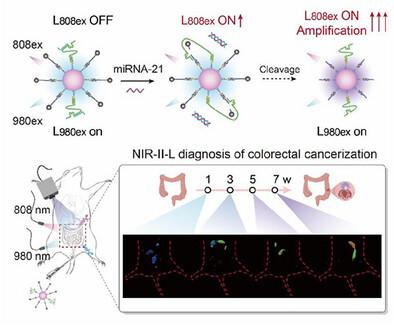当前位置:
X-MOL 学术
›
Adv. Mater.
›
论文详情
Our official English website, www.x-mol.net, welcomes your
feedback! (Note: you will need to create a separate account there.)
Non‐Invasive Diagnosis of Early Colorectal Cancerization via Amplified Sensing of MicroRNA‐21 in NIR‐II Window
Advanced Materials ( IF 27.4 ) Pub Date : 2025-03-24 , DOI: 10.1002/adma.202501378
Fuheng Zhai 1, 2 , Baofeng Yun 2 , Jiang Ming 2 , Tianyu Yu 1 , Benhao Li 2 , Xiao Liu 2 , Xusheng Wang 2 , Zi-Han Chen 2 , Changfeng Song 1 , Mengyao Zhao 2 , Wenlin Li 3 , Zhebin Liu 4 , Aibin Liang 5 , Jiyu Li 1, 6 , Fan Zhang 1, 2, 5
Advanced Materials ( IF 27.4 ) Pub Date : 2025-03-24 , DOI: 10.1002/adma.202501378
Fuheng Zhai 1, 2 , Baofeng Yun 2 , Jiang Ming 2 , Tianyu Yu 1 , Benhao Li 2 , Xiao Liu 2 , Xusheng Wang 2 , Zi-Han Chen 2 , Changfeng Song 1 , Mengyao Zhao 2 , Wenlin Li 3 , Zhebin Liu 4 , Aibin Liang 5 , Jiyu Li 1, 6 , Fan Zhang 1, 2, 5
Affiliation

|
Accurate, sensitive, and in situ visualization of aberrant expression level of low‐abundant biomolecules is crucial for early colorectal cancer (CRC) detection ahead of tumor morphology change. However, the clinical used colonoscopy and biopsy methods are invasive and lack of sensitivity at early‐stage of cancerization. Here, an amplified sensing strategy is developed in the second near‐infrared long‐wavelength subregion (NIR‐II‐L, 1500–1900 nm) by integrating DNAzyme‐triggered signal amplification technology and lanthanide‐dye hybrid system. In the early‐stage of CRC, the overexpressed biomarker microRNA‐21 initiates the NIR‐II‐L luminescence ratiometric signal amplification of the CRCsensor. The high sensitivity with a limit of detection (LOD) of 1.26 pm allows non‐invasive visualization of orthotopic colorectal cancerization via rectal administration, which achieves early and accurate in situ diagnosis at 2 weeks ahead of the in vitro histological results. This innovative approach offers a promising tool for early diagnosis and long‐term monitoring of carcinogenesis progression, with potential applications in other cancer‐related biomarkers.
中文翻译:

通过在 NIR-II 窗口中扩增 microRNA-21 的传感对早期结直肠癌变进行无创诊断
低丰度生物分子异常表达水平的准确、灵敏和原位可视化对于在肿瘤形态变化之前进行早期结直肠癌 (CRC) 检测至关重要。然而,临床上使用的结肠镜检查和活检方法是侵入性的,并且在癌症化的早期缺乏敏感性。在这里,通过整合 DNAzyme 触发的信号放大技术和镧系元素-染料杂化系统,在第二个近红外长波长亚区域 (NIR-II-L, 1500–1900 nm) 开发了一种放大传感策略。在 CRC 的早期阶段,过表达的生物标志物 microRNA-21 启动 CRCsensor 的 NIR-II-L 发光比例信号放大。检测限 (LOD) 为 1.26 pm 的高灵敏度允许通过直肠给药对原位结直肠癌变进行无创可视化,从而在体外组织学结果前 2 周实现早期和准确的原位诊断。这种创新方法为早期诊断和长期监测致癌进展提供了一种有前途的工具,并可能应用于其他癌症相关的生物标志物。
更新日期:2025-03-24
中文翻译:

通过在 NIR-II 窗口中扩增 microRNA-21 的传感对早期结直肠癌变进行无创诊断
低丰度生物分子异常表达水平的准确、灵敏和原位可视化对于在肿瘤形态变化之前进行早期结直肠癌 (CRC) 检测至关重要。然而,临床上使用的结肠镜检查和活检方法是侵入性的,并且在癌症化的早期缺乏敏感性。在这里,通过整合 DNAzyme 触发的信号放大技术和镧系元素-染料杂化系统,在第二个近红外长波长亚区域 (NIR-II-L, 1500–1900 nm) 开发了一种放大传感策略。在 CRC 的早期阶段,过表达的生物标志物 microRNA-21 启动 CRCsensor 的 NIR-II-L 发光比例信号放大。检测限 (LOD) 为 1.26 pm 的高灵敏度允许通过直肠给药对原位结直肠癌变进行无创可视化,从而在体外组织学结果前 2 周实现早期和准确的原位诊断。这种创新方法为早期诊断和长期监测致癌进展提供了一种有前途的工具,并可能应用于其他癌症相关的生物标志物。

































 京公网安备 11010802027423号
京公网安备 11010802027423号